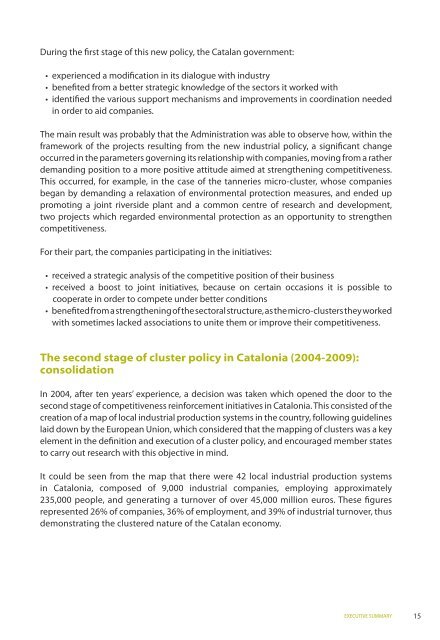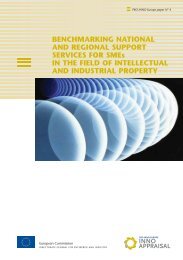Clusters and competitiveness - PRO INNO Europe
Clusters and competitiveness - PRO INNO Europe
Clusters and competitiveness - PRO INNO Europe
You also want an ePaper? Increase the reach of your titles
YUMPU automatically turns print PDFs into web optimized ePapers that Google loves.
During the first stage of this new policy, the Catalan government:<br />
• experienced a modification in its dialogue with industry<br />
• benefited from a better strategic knowledge of the sectors it worked with<br />
• identified the various support mechanisms <strong>and</strong> improvements in coordination needed<br />
in order to aid companies.<br />
The main result was probably that the Administration was able to observe how, within the<br />
framework of the projects resulting from the new industrial policy, a significant change<br />
occurred in the parameters governing its relationship with companies, moving from a rather<br />
dem<strong>and</strong>ing position to a more positive attitude aimed at strengthening <strong>competitiveness</strong>.<br />
This occurred, for example, in the case of the tanneries micro-cluster, whose companies<br />
began by dem<strong>and</strong>ing a relaxation of environmental protection measures, <strong>and</strong> ended up<br />
promoting a joint riverside plant <strong>and</strong> a common centre of research <strong>and</strong> development,<br />
two projects which regarded environmental protection as an opportunity to strengthen<br />
<strong>competitiveness</strong>.<br />
For their part, the companies participating in the initiatives:<br />
• received a strategic analysis of the competitive position of their business<br />
• received a boost to joint initiatives, because on certain occasions it is possible to<br />
cooperate in order to compete under better conditions<br />
• benefitedfromastrengtheningofthesectoralstructure,asthemicro-clusterstheyworked<br />
with sometimes lacked associations to unite them or improve their <strong>competitiveness</strong>.<br />
The second stage of cluster policy in Catalonia (2004-2009):<br />
consolidation<br />
In 2004, after ten years’ experience, a decision was taken which opened the door to the<br />
second stage of <strong>competitiveness</strong> reinforcement initiatives in Catalonia.This consisted of the<br />
creation of a map of local industrial production systems in the country, following guidelines<br />
laid down by the <strong>Europe</strong>an Union, which considered that the mapping of clusters was a key<br />
element in the definition <strong>and</strong> execution of a cluster policy, <strong>and</strong> encouraged member states<br />
to carry out research with this objective in mind.<br />
It could be seen from the map that there were 42 local industrial production systems<br />
in Catalonia, composed of 9,000 industrial companies, employing approximately<br />
235,000 people, <strong>and</strong> generating a turnover of over 45,000 million euros. These figures<br />
represented 26% of companies, 36% of employment, <strong>and</strong> 39% of industrial turnover, thus<br />
demonstrating the clustered nature of the Catalan economy.<br />
EXECUTIVE SUMMARY<br />
15
















